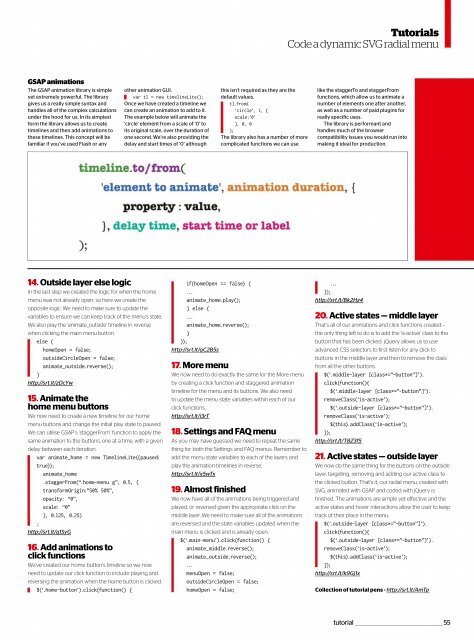Web_Designer_UK__May_2018
Create successful ePaper yourself
Turn your PDF publications into a flip-book with our unique Google optimized e-Paper software.
Tutorials<br />
Code a dynamic SVG radial menu<br />
GSAP animations<br />
The GSAP animation library is simple<br />
yet extremely powerful. The library<br />
gives us a really simple syntax and<br />
handles all of the complex calculations<br />
under the hood for us. In its simplest<br />
form the library allows us to create<br />
timelines and then add animations to<br />
these timelines. This concept will be<br />
familiar if you’ve used Flash or any<br />
other animation GUI.<br />
var tl = new timelineLite();<br />
Once we have created a timeline we<br />
can create an animation to add to it.<br />
The example below will animate the<br />
‘circle’ element from a scale of ‘0’ to<br />
its original scale, over the duration of<br />
one second. We’re also providing the<br />
delay and start times of ‘0’ although<br />
this isn’t required as they are the<br />
default values.<br />
tl.from(<br />
‘circle’, 1, {<br />
scale:’0’<br />
}, 0, 0<br />
);<br />
The library also has a number of more<br />
complicated functions we can use<br />
like the staggerTo and staggerFrom<br />
functions, which allow us to animate a<br />
number of elements one after another,<br />
as well as a number of paid plugins for<br />
really specific uses.<br />
The library is performant and<br />
handles much of the browser<br />
compatibility issues you would run into<br />
making it ideal for production.<br />
14. Outside layer else logic<br />
In the last step we created the logic for when the home<br />
menu was not already open, so here we create the<br />
opposite logic. We need to make sure to update the<br />
variables to ensure we can keep track of the menu’s state.<br />
We also play the ‘animate_outside’ timeline in reverse<br />
when clicking the main menu button.<br />
else {<br />
homeOpen = false;<br />
outsideCircleOpen = false;<br />
animate_outside.reverse();<br />
}<br />
http://srt.lt/zDcYw<br />
15. Animate the<br />
home menu buttons<br />
We now need to create a new timeline for our home<br />
menu buttons and change the initial play state to paused.<br />
We can utilise GSAP’s ‘staggerFrom’ function to apply the<br />
same animation to the buttons, one at a time, with a given<br />
delay between each iteration.<br />
var animate_home = new TimelineLite({paused:<br />
true});<br />
animate_home<br />
.staggerFrom(“.home-menu g”, 0.5, {<br />
transformOrigin:”50% 50%”,<br />
opacity: “0”,<br />
scale: “0”<br />
}, 0.125, 0.25)<br />
;<br />
http://srt.lt/q1SyG<br />
16. Add animations to<br />
click functions<br />
We’ve created our home button’s timeline so we now<br />
need to update our click function to include playing and<br />
reversing the animation when the home button is clicked.<br />
$(‘.home-button’).click(function() {<br />
if(homeOpen == false) {<br />
...<br />
animate_home.play();<br />
} else {<br />
...<br />
animate_home.reverse();<br />
}<br />
});<br />
http://srt.lt/qC2B5s<br />
17. More menu<br />
We now need to do exactly the same for the More menu<br />
by creating a click function and staggered animation<br />
timeline for the menu and its buttons. We also need<br />
to update the menu state variables within each of our<br />
click functions.<br />
http://srt.lt/i3rT<br />
18. Settings and FAQ menu<br />
As you may have guessed we need to repeat the same<br />
thing for both the Settings and FAQ menus. Remember to<br />
add the menu state variables to each of the layers and<br />
play the animation timelines in reverse.<br />
http://srt.lt/x5wTx<br />
19. Almost finished<br />
We now have all of the animations being triggered and<br />
played, or reversed given the appropriate click on the<br />
middle layer. We need to make sure all of the animations<br />
are reversed and the state variables updated when the<br />
main menu is clicked and is already open.<br />
$(‘.main-menu’).click(function() {<br />
animate_middle.reverse();<br />
animate_outside.reverse();<br />
...<br />
menuOpen = false;<br />
outsideCircleOpen = false;<br />
homeOpen = false;<br />
...<br />
});<br />
http://srt.lt/Bk2Hz4<br />
20. Active states — middle layer<br />
That’s all of our animations and click functions created –<br />
the only thing left to do is to add the ‘is-active’ class to the<br />
button that has been clicked. jQuery allows us to use<br />
advanced CSS selectors to first listen for any click to<br />
buttons in the middle layer and then to remove the class<br />
from all the other buttons.<br />
$(‘.middle-layer [class*=”-button”]’).<br />
click(function(){<br />
$(‘.middle-layer [class*=”-button”]’).<br />
removeClass(‘is-active’);<br />
$(‘.outside-layer [class*=”-button”]’).<br />
removeClass(‘is-active’);<br />
$(this).addClass(‘is-active’);<br />
});<br />
http://srt.lt/T8Z3f5<br />
21. Active states — outside layer<br />
We now do the same thing for the buttons on the outside<br />
layer, targeting, removing and adding our active class to<br />
the clicked button. That’s it, our radial menu, created with<br />
SVG, animated with GSAP and coded with jQuery is<br />
finished. The animations are simple yet effective and the<br />
active states and hover interactions allow the user to keep<br />
track of their place in the menu.<br />
$(‘.outside-layer [class*=”-button”]’).<br />
click(function(){<br />
$(‘.outside-layer [class*=”-button”]’).<br />
removeClass(‘is-active’);<br />
$(this).addClass(‘is-active’);<br />
});<br />
http://srt.lt/k9Gj1x<br />
Collection of tutorial pens - http://srt.lt/AmTp<br />
tutorial _________________________________________________55



